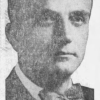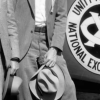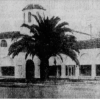By Harrison Power
When it comes to Modesto’s built environment, as well as its preserved green spaces, among the advocates and leaders at the forefront of Modesto’s early 20th Century development was Herbert W. Ramont (1895-1980), who worked in close partnership with his wife, Hollis Moore Ramont (1897-1979). Ramont, a local home designer and innovative developer, left his mark in Modesto through whimsical and creatively designed homes in the La Loma and College Area neighborhoods, the creation of Legion Park along the Tuolumne River, and years of public service.
Herb Ramont graduated from Modesto High School in 1915 and studied civil engineering at the University of California, Berkeley, later enlisting to serve in the American Expeditionary Force as a machinist and ambulance driver in France during World War 1 from 1917 until arriving back home in 1919. After returning, he co-founded the United Automotive Service station at 12th and J Streets in 1920. The following year, Ramont married Hollis Moore in Berkeley on December 31, 1921.
By the mid-to-late 1920’s, Herb Ramont had begun venturing into development and home design. Herb and Hollis Ramont were among the owners of and signatories to the Elmwood Court tract subdivision in 1927. His first home design in Modesto was reported to have been in 1929, and from there he also went on to design commercial buildings in Downtown, including the no-longer-standing 1930 “La Casa de las Tiendas” at the corner of 16th and J Streets, and homes along Dry Creek in the newly subdivided La Loma blocks in the 1930’s, including his own home at 315 El Rio Avenue. The homes he designed were primarily of the Spanish and Old World styles, and can still be found on El Rio Avenue, La Loma Avenue, Wilson Avenue, Morton Boulevard, River Road, and Elmwood Court. Notably not a trained architect, his wife Hollis was known to have been the one to draft plans and sketch out designs based on Herb’s vision and ideas. A testament to his extensive influence in building design and civic development, Herb Ramont served on the Modesto Planning Commission from 1931 to 1954.
In addition to his residential and commercial development, Herb Ramont shared a passion for preserving and embracing open spaces, especially along Modesto’s waterways. Through his affiliation with the American Legion Post 74, in the early 1930’s Herb Ramont took an option on the 5-acre parcel on the Tuolumne River adjacent to the Legion Hall, and with the land secured by the Legion, offered to donate the land to the City of Modesto for parkland pending completion of a dam downstream, when the Dennett Dam was dedicated on July 4, 1933. His vision for recreational space grew from there, into an idea for a 200-mile state park along the San Joaquin and Tuolumne Rivers, essentially connecting “the Sierra to the Sea.” While that may not have come to fruition, progress was made at the time to support Tuolumne River recreation, and today Tuolumne River Regional Park is one the crown jewels of Modesto’s parks and outdoor recreation.
In September 1982, the Modesto Bee featured an article deeming Ramont to be “a man ahead of his time.” From his several surviving homes, to having been an early leading voice for expanding Modesto’s park resources, Ramont’s visions for what housing could be and for how Modesto should pursue growth are as prescient now as they were decades ago. So whether going for a drive in one of Modesto’s historic neighborhoods, or spending time outdoors in one of Modesto’s many parks, Herb and Hollis Ramont can be thanked for their early impact on Modesto home development and parks and recreation advocacy.












